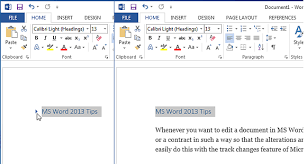Unveiling Efficiency: A Comprehensive Exploration of Collapsing and Expanding Documents in Microsoft Word 2013

Introduction:
Efficiency in document management is a cornerstone in the evolving landscape of word processing. Microsoft Word 2013 introduces a transformative feature that redefines how users interact with extensive documents – the ability to collapse and expand sections. This article embarks on an extensive exploration of this powerful functionality, unraveling its nuances, and showcasing how it empowers users to navigate, organize, and streamline their documents within the familiar Word environment.
The Unveiling of Collapsible Sections:
Microsoft Word 2013 brings a paradigm shift in document organization by introducing collapsible sections. This feature allows users to collapse parts of their document, condensing the view to show only the section headings. By doing so, users can gain a bird’s-eye view of the document’s structure, simplifying navigation and making it easier to focus on specific sections without being overwhelmed by the entire content.
Effortless Navigation with the Navigation Pane:
At the heart of the collapsing and expanding functionality is the Navigation Pane, a powerful tool that enhances document navigation in Microsoft Word 2013. The Navigation Pane displays an interactive outline of the document’s structure, including collapsible sections and headings. Users can effortlessly jump between sections, making it a breeze to navigate lengthy documents with precision.
Collapsing Sections: Streamlining Document Views
Collapsing sections in Microsoft Word 2013 is a straightforward yet impactful process. Users can hover over the desired section heading in the Navigation Pane and click the small arrow that appears. Alternatively, users can utilize the handy shortcut provided in the Ribbon under the “View” tab. With a simple click, the selected section collapses, presenting users with a condensed and organized view of their document.
The Art of Expanding Sections:
While collapsing sections offers a macro-level overview, expanding sections in Microsoft Word 2013 allows users to delve into the details. Users can easily expand a collapsed section by clicking on the arrow next to the section heading in the Navigation Pane. This seamless expansion and collapse dynamic grants users unparalleled control over the level of detail they wish to engage with in their document.
Nested Sections: Hierarchical Organization:
Microsoft Word 2013’s collapsing and expanding functionality extends to nested sections, providing users with a hierarchical organization tool. Nested sections allow for the creation of sub-sections within larger sections, fostering a structured and intuitive document hierarchy. Users can collapse or expand both parent and child sections independently, tailoring their document view to match their workflow preferences.
Improved Document Focus and Productivity:
The collapsing and expanding feature in Microsoft Word 2013 directly contributes to improved document focus and overall productivity. Users can concentrate on specific sections without the distraction of irrelevant content. This targeted approach proves especially beneficial during editing, reviewing, or collaborative work, allowing users to streamline their efforts and enhance their overall workflow.
Collapsing Tables and Graphics:
Microsoft Word 2013’s collapsing and expanding functionality isn’t limited to text alone; it extends its capabilities to tables and graphics within a document. Users can collapse complex tables or graphics, simplifying the document view and allowing for a more comprehensive understanding of the overall content structure. This versatility ensures that users can adapt the collapsing and expanding feature to various document elements.
Integration with Document Outline:
The collapsing and expanding feature seamlessly integrates with the Document Outline view in Microsoft Word 2013, offering users an alternative way to visualize and navigate their document structure. The Document Outline provides a hierarchical overview of headings and sections, allowing users to collapse or expand sections directly from this view, further enhancing the flexibility and convenience of document management.
Collapsing and Expanding in Print Layout and Web Layout:
Microsoft Word 2013’s collapsing and expanding functionality is not limited to a single view. Users can leverage this feature in both Print Layout and Web Layout views, ensuring a consistent and flexible experience across different document representations. This adaptability is essential for users who switch between views based on their specific document needs.
Collapsing and Expanding in Reading View:
For users who prefer the Reading View in Microsoft Word 2013, the collapsing and expanding feature remains an integral part of the reading experience. Readers can collapse or expand sections to customize their reading environment, allowing for a focused and tailored approach to consuming lengthy documents. This feature enhances the reading experience, making it more immersive and user-friendly.
Collapsing and Expanding in Compatibility Mode:
Microsoft Word 2013’s collapsing and expanding functionality is not restricted to documents created within its native format. Users can benefit from these features even when working with documents in Compatibility Mode, ensuring that the advantages of efficient document organization are extended to legacy documents.
Accessibility and Document Collaboration:
In an era of collaborative workspaces and accessibility, Microsoft Word 2013’s collapsing and expanding feature stands out for its inclusivity. Collaborators can seamlessly navigate and understand the document structure, even if they do not actively use the collapsing and expanding feature. This ensures that the benefits of organized document views are not exclusive to the creator but are shared among collaborators.
Customization and User Preferences:
Recognizing the diverse needs of users, Microsoft Word 2013’s collapsing and expanding feature offers customization options. Users can adjust settings to collapse or expand sections by default, tailoring the document view to match their individual preferences. This flexibility ensures that users can personalize their document management experience based on their specific workflow requirements.
Conclusion:
As we navigate the expansive landscape of document creation, Microsoft Word 2013’s collapsing and expanding feature emerges as a transformative tool. From the streamlined organization of extensive documents to the improved focus during editing and collaboration, this functionality reshapes the way users interact with their documents. Microsoft Word 2013’s commitment to user-centric design and enhanced productivity is evident in the seamless integration of collapsing and expanding features, offering users a powerful and dynamic solution for efficient document management. Welcome to the future of document organization, where precision meets flexibility in the world of Microsoft Word 2013.







